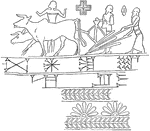
The Seal
"The seal, adapted principally for water. The extremities are larger than in the porpoise and manatee."—Pettigrew,…

The Turtle
"The turtle, adapted for swimming and diving, the extremities being relatively larger than in the seal,…

Babylonian Seal Impression
Pictured are men plowing a sowing. This illustration is from a Babylonian seal impression from the 14th…

Argentine Ant
Image of an Argentine ant. This destructive insect is native to parts of South America, but was accidentally…

Human Leg (Front View), and Comparative Diagrams showing Modifications of the Leg
This illustration shows a human leg (front view), and comparative diagrams showing modifications of…

Leg of Seal
This illustration shows the leg of a seal. P. Pelvis, FE. Femur, TI. Tibia, FI. Fibula, TA. Tarsus,…

Elephant Seal on a Rock
"The seal Macrorhinus elephantinus or proboscideus, or Morunga proboscidea. It is the largest of the…

Seal Swimming up to an Igloo
Illustration of the entrance of an igloo, built out of ice, partially underwater. A seal is swimming…

Leopard Seal
Leptonychotes weddelli. "A spotted seal of the southern and antarctic seas, belonging to the family…

Seal Press
"A press or stamp bearing dies on its jaws, or a die and a bed, for imprinting or embossing any device…

Skippet - Open Box with a Seal Inside
"A circular box used for covering and protecting a seal. Old documents were commonly sealed by means…
